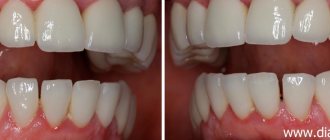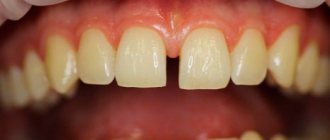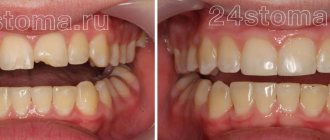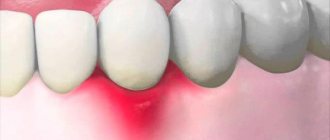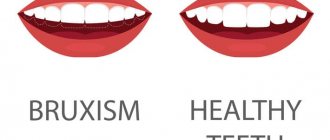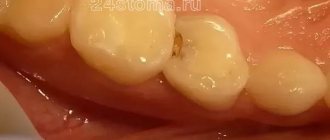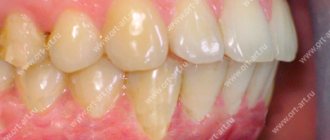According to statistics, every fifth person on the planet suffers from diastema - a gap between the front teeth. This is considered normal, especially if the cleft is small. But both large and small diastemas often become the causes of complexes and even various dental problems. Therefore, it is advisable for anyone who has a gap between their incisors to visit an orthodontist and find out from him how to close the gap between the front teeth . Most often, treatment does not take much time, although it does require some investment.
Interestingly, a gap between teeth is considered a sign of creativity and significant talent. Some say that a man with a gap between his incisors is distinguished by a kind and cheerful disposition, and a woman with such a feature of appearance is prone to romantic love. Also, those with a small distance between their teeth are credited with special sensuality and the ability to enjoy the little things.
What is the correct name for the gap between the front teeth?
The correct name for the gap between the front teeth is diastema, which goes back to the Greek word diástema (Greek διαστημα). The term means "distance", "span" or "interval". Although in Greece the word was used without reference to dental disease, today diastema refers specifically to a dental problem.
A more simplified, but also correct name for the gap between the teeth is a gap or chip. This word is used primarily in literary language and works of art. But no matter what you call the problem, it still needs to be treated: although diastema is not the most unpleasant dental pathology, it remains a defect that can cause a number of dental problems.
Treatment of diastemas with before and after photos
From this article you will learn about the causes of diastema, ways to eliminate the gap between the front teeth with before and after photos, as well as prevention methods. In adults and in children.
Dental diastema is the distance between the front central incisors. Happens to 10 - 20% of people. More often found on the upper jaw, less often on the lower jaw.
For some, the gap between the front teeth is an aesthetic “highlight” of a person, but it can negatively affect diction - whistling sounds. This defect can be left unchanged. There are negative consequences of this inaction. About them at the end of the article.
Causes:
- 1. Small size of incisors (1-2%).
- 2. Incorrect position of the front teeth due to malocclusion (4-7%).
- 3. Displacement of the front teeth due to increased load due to the loss of chewing teeth (5-8%).
- 4. But the main reason is one (up to 90%) - the presence of a pronounced frenulum of the lip, which prevents the central teeth from being next to each other.
Types of diastemas
- false - with baby teeth. It can close on its own when the permanent ones erupt.
- true - when all permanent teeth are already in place.
Prevention and treatment in children
With the help of a banal micro surgical intervention - trimming the frenulum of the upper lip. Then the gap will close itself in adolescence. If this graceful time is missed, it will have to be eliminated in the future by other means.
Why does a gap appear between the front teeth?
To understand how to remove the gap between the incisors, you need to understand the causes of this problem. In some cases, diastema is a variant of the norm; it develops if a person grows small teeth with wide upper gums. It is not necessary to fix a small neat gap, as it is more of an aesthetic problem. It is usually hereditary.
This pathology can also occur due to the following reasons:
- too late or early change of teeth;
- congenital absence of one or more teeth (edentia);
- anomaly in the shape or size of the incisors;
- tongue frenulum too low.
Sometimes diastema occurs due to bad habits of chewing pens, pencils and other objects. In adults, a problem arises when the upper molars are lost: the human body is designed in such a way that when a void forms between the teeth, the remaining elements try to fill it, so the molars, incisors and canines diverge slightly and move. This happens very slowly, but eventually sometimes leads to the formation of gaps between the teeth.
Another cause of diastema is severe malocclusion and crooked teeth. Sometimes, if treated incorrectly, the incisors do not fit into place quite correctly, leaving a gap. In this case, it is necessary to continue visiting the orthodontist and complete the adjustment of the dentition.
You can read more about changes in bite and dental anomalies in a separate article on our website: All about bite: what it is like, why it is important to monitor it and how to treat improperly grown teeth.
Do you feel like your teeth are uneven?
Read more detailed information about the causes of malocclusion in the interesting material of an orthodontist, Ph.D. Gevorkyan T.V. " Eight Causes of Crooked Teeth in Adults
"
In conclusion, what is the best way to straighten your teeth?
As you know, there are several methods, but the main ones are braces, aligners and veneers. In the first two cases, we are really talking about correcting the bite, and veneers are, say, only cosmetic work. But the question still remains - WHAT to choose, what braces to put on? Or stick with aligners?
comparative analysis may come in handy
these methods of treating malocclusion. More than 70 parameters (!), but the material is very easy to read. And we hope it will help you make your choice.
For children
— the main methods of correcting malocclusion are plates, myofunctional trainers, functional devices and “2x4 braces.” You can read about the pros and cons of these methods HERE.
Is it possible to get rid of gaps between teeth?
If you have diastema, you should definitely visit an orthodontist, since getting rid of gaps in your teeth is not only possible, but also necessary. Modern treatment methods make it possible to cope with such a problem quite quickly, and dentists offer a large selection of methods for hiding the gap.
The only situation where treatment is not required is diastema on baby teeth in children. This is considered normal and does not require medical intervention. Over time, when the bite changes, the teeth take on the correct position on their own.
A small diastema on baby teeth is normal.
Reasons for the appearance and enlargement of gaps between teeth
The gap between the front teeth is a result of internal or external factors. Most often it occurs as a result of:
The cause may also be the presence of microdentia, which inherently affects the symmetry of the teeth.
An increase in an existing gap occurs for the following reasons:
- abuse of chewing seeds;
- progressive problems with the root system;
- the appearance/development of various types of orthodontic pathologies;
- Frequent chewing of hard food (particularly with the front teeth).
Correct and recommended prevention will help maintain the diastema at the existing level (prevent the distance between the incisors from becoming larger), and the orthodontist will select an individual program for eliminating the defect.
You might be interested in:
Types of teeth bites
Straightening teeth without braces
Treatment and straightening of teeth
Clear braces
Types of diastemas
There are many types of diastemas. They are mainly classified according to the following features:
- False or true. False diastema occurs in children and is considered a type of normal. It disappears on its own after changing the bite. The teeth are not harmed. True diastema is permanent and requires treatment.
- Symmetry. There is a symmetrical cleft, in which the incisors have the same shift relative to each other, and an asymmetrical one, when one of the front teeth occupies the correct position, and the second is shifted. The latter is the most dangerous, because it disrupts the correctness of the dentition.
- Direction of the vertical axis of the incisors. It can be lateral, when the roots are parallel and the crowns diverge, corpus, if the tooth moves along with the root, and medial, when the incisors grow to the side or rotate around their axis.
False and small symmetrical diastemas are practically safe. The first will disappear on its own, the second is just a cosmetic defect. If the position of the tooth root is disturbed or the gap between the incisors is too large, it is better to consider treatment options.
Trema or diastema?
In adults, we most often see noticeable disproportionate gaps ranging in size from 0.3 to 0.7 mm between the central incisors of the upper, and less commonly, the lower jaw. These are diastemas. As long as they do not affect the functioning of the dental system and clarity of speech, diastema is regarded as a normal variant. If this anomaly has unpleasant consequences, it is better to involve a dentist in the case.
The spaces between any other teeth on the jaw are called teeth. They are the norm for children with primary and transitional dentition, when the width of the crowns of primary teeth remains constant, and the jaw arch lengthens month by month. In adults, trema is always a problem.
The reasons for the development of three and diastemas are various. This must be taken into account when planning examination and treatment.
Ways to correct gaps between teeth
The choice of treatment for diastema depends on the reasons for its development, the size of the gap, the characteristics of the patient’s jaw and his budget. The doctor also assesses the patient’s age and the condition of the dentition. All methods can be divided into cosmetic (hiding the problem) and therapeutic (changing the position of the teeth using correction tools). Let's consider the features of each method separately.
Braces
Installing braces is a classic way to eliminate dental deficiencies. They are a non-removable orthodontic structure that is attached to the teeth for a significant period. A variety of braces can eliminate even complex malocclusions, which makes such systems very versatile. During the existence of braces, several varieties of these orthodontic devices have appeared:
- Metal. The most popular and cheapest type of braces. They have a medium size and high efficiency, at a fairly affordable price. Very noticeable on teeth.
- Plastic. They look more aesthetically pleasing than metal ones and do not damage the enamel as much, but when wearing them you should not drink coffee, tea or products that color plastic, as it absorbs the colors.
- Ceramic. The most expensive and beautiful option of braces. They are completely safe, do not change color, and are almost invisible on the teeth.
- Sapphire. They belong to the ceramic group, but require less wearing time than classic models.
There are also gold braces - a premium treatment system, fancy and expensive, and various variations of plastic, metal, ceramics, for example, models with colored ligatures or overlays in the form of hearts, stars and other figures.
Appearance of different types of braces
The maximum effectiveness is shown by wearing braces at the age of 16 to 20 years, when the dentition has already completely changed, but remains quite mobile, because the bone tissue of the jaw is not fully formed. Treatment at this age gives stable and long-lasting results.
The main advantages of braces systems are:
- high efficiency;
- comparative safety;
- the ability to install a hidden bite correction system.
This method of treatment also has disadvantages, namely:
- long wearing period (from one year to 3 years);
- high cost of aesthetic types (sapphire, lingual);
- the need for specialized care, otherwise the risk of developing caries increases;
- Constant wear; braces cannot be removed for an event or during a trip.
Records
The principle of operation of the plate is similar to braces, but it looks different and can be removed from the teeth for a short time. The plates work best at an early age - up to 12 years. At this time, the bone tissue of the jaw is still soft, so the position of the teeth is easy to correct.
Plates for correcting bite
The advantages of records are:
- safety of treatment;
- high efficiency;
- the ability not to wear the product all the time;
Disadvantages of the system:
- may cause discomfort when wearing;
- not suitable for correcting serious defects.
Mouthguards
Mouthguards are orthodontic devices that are placed on the teeth, somewhat reminiscent of covers. They are made specifically for the patient using 3D technology and are sent as a set after taking measurements. The idea is to wear covers that put a little pressure on the teeth at first, then more and more even variations. As a result, the cutters snap into place under plastic pressure.
Transparent aligners are invisible on the teeth
The advantages of mouth guards are:
- ease of maintenance of plastic structures;
- comparative invisibility;
- high efficiency and the ability to simultaneously correct other malocclusions.
Disadvantages of this type of treatment:
- transparent aged aligners are still visible on the teeth and attract attention;
- the patient must strictly adhere to the wearing regime, otherwise the entire set of covers will have to be completely remade (they are made at one time).
Veneers and Lumineers
Veneers are microprostheses that are placed on the outer surface of the tooth. They hide the incisor and allow you to close the gap. Lumineers are made in much the same way as veneers, but they are much thinner and more discreet. Both types of onlays are made from modern materials that closely resemble real teeth, do not change over time and do not cause allergies.
Advantages of veneers and lumineers:
- quick effect, literally in 1-2 doses;
- durability of the onlays (veneers last 10 years, lumineers - about 20);
- impeccable appearance.
Disadvantages of products:
- there are contraindications, for example, veneers and lumineers cannot be placed if a person suffers from bruxism or increased tooth wear;
- cannot be used during an extreme lifestyle (the microprosthesis may fall off).
Veneers, unlike lumineers, have another significant drawback - teeth are ground down to fit them. Lumineers only affect the top layer of enamel, but their price is much higher.
Crowns
When treating diastema in adults, doctors often recommend installing crowns. These permanent structures completely cover the incisor, hiding the gap. At the same time, installing a crown completely restores the functionality of the tooth. True, it has to be sharpened. But, if the incisor has already suffered, for example, it has chipped or been susceptible to caries, this type of treatment is quite justified.
When installing a crown, grinding of the tooth is used
When installing a crown, it is very important to choose the right material. Until recently, there was only one option - metal, most often gold. The cheapest, but also the most visible type of crown. Today it is possible to install products that are very similar to real teeth, for example, ceramic (made of porcelain, aluminum oxide, zirconium dioxide) or metal-plastic. The latter are the cheapest, but can cause irritation to the delicate mucous membranes.
Advantages of crowns:
- safe and effective method;
- you can protect damaged teeth;
- lasts 10-20 years;
- result after several visits to the dentist.
Flaws:
- grinding of the tooth is required, which is unreasonable to do on healthy incisors;
- A crown made of high-quality materials is an expensive solution.
Implants
An implant is an artificial tooth that is mounted on a metal pin secured inside the jawbone. This is the most expensive and highest quality method of restoring teeth if their roots have died and are not preserved. When implants are installed, the functionality of the incisor is completely restored. The pins themselves are made primarily of titanium and are divided by type (each for its own type of tooth: molar, incisor, canine). Crowns can be made from different materials, but metal-ceramics are the most popular, since they stand out the least in the dentition.
Blank for implant installation
The advantages of installing an implant are:
- the effectiveness of the procedure for tooth restoration;
- quick visible results;
- service life is lifelong.
Disadvantages of technology:
- implantation is an operation that requires appropriate preparation;
- it is not always possible to insert a pin into the bone (it may be too thin);
- You will always have a permanent piece of metal with you, this causes certain problems (increased attention from security, inability to undergo an MRI, etc.).
Cosmetic correction
Cosmetic correction is the hiding of the diastema by forming a small filling attached to the sides of the incisors. Essentially, the specialist covers the gap with filling material. This is the simplest and cheapest method that does not harm the teeth.
Advantages:
- harmlessness with high efficiency;
- visible results after the first dose;
- no contraindications.
Flaws:
- if the filling materials were not of sufficient quality, they may change color, disturbing the aesthetics of the dentition;
- on average, a filling lasts 5-7 years, it will have to be changed, it may fall out;
- the incisors will not be able to work fully, the load on them will have to be reduced, otherwise this will lead to damage to the filling.
Artistic restoration
Unlike cosmetic correction, artistic restoration is a more complex procedure that gives a better result. With this method of closing a diastema, the doctor does not simply place a filling, but applies composite materials to the front teeth in layers. As a result, the result looks natural and does not require maintenance or replacement.
Pros of the procedure:
- after one or two visits the result is visible;
- with the help of restoration you can hide quite large distances;
- there are no contraindications;
- Composite materials do not change color over time.
Flaws:
- high price;
- not all diastemas can be corrected in this way;
- you will have to reduce the load on the incisors so as not to damage the composite.
Surgical plastic surgery
Surgery is required if the diastema forms due to abnormal growth of the frenulum. Typically, such an operation is performed in childhood or adolescence, then with the help of orthodontic structures to return the teeth to the correct position. The ideal time for the operation is 5-8 years, since the frenulum will not go away with age. If the child had surgery before the primary bite was changed, the permanent teeth will grow correctly.
Problematic frenulum, its plastic surgery and results
Advantages:
- high efficiency;
- a birth defect is eliminated;
- does not require correction in the future.
Flaws:
- the operation requires appropriate preparation;
- teeth can take several years to fall back into place.
Considering that diastema in children is a normal phenomenon, you need to regularly visit a doctor for examination. It is quite possible that an inexperienced parent will not see the problematic frenulum and will attribute the appearance of gaps to childhood. This is dangerous, because any disturbances in the oral cavity harm not only the teeth, but also the gastrointestinal tract, ability to speak, change the smile, etc.
Restoration of diastemas with composite material
When all the teeth are in a normal position and the only concern is the distance between the front teeth, this can be beautifully, easily and quickly corrected with a composite material. In the patient's mouth for an hour and a half. This type of correction is called a filling, artistic restoration, or direct veneer. how it's done
- A composite material is applied to the lateral surfaces of the teeth without treatment, changing their shape and closing the gap between the teeth.
deadlines
- It will take one to two hours for both teeth.
pros
- This is the most non-traumatic
way to eliminate diastema. - The fastest way to close diastemas of all.
- Complete absence of dental treatment. No boron! Absolutely atraumatic for teeth and their nerves.
- No negative impact on the tooth and nerve.
- The likelihood of dental problems is the same as without intervention.
- The strength of the teeth is not impaired - you can bite off any acceptable food.
minuses
- We need a highly qualified dentist. With a lot of experience. Otherwise, closing the diastema will look like a filling and not an artistic restoration.
- The doctor must have a variety of aesthetic and proven materials available. To eliminate the defect beautifully and permanently. If performed poorly, the appearance of the teeth will not be ideal.
- When the distance between the front teeth is more than 2mm, the results are not always ideal:
In such cases, treatment with braces is more suitable. Or you have to use the lateral incisors. To prevent the central ones from becoming too wide: cost
- 6600-13200 rubles for one direct veneer. Depends on the scope of the intervention.
forecast
- When the work is done by a true master, composite veneers will last up to 10 - 16 years.
- Poor oral hygiene may require polishing. Once every two to four years. Takes 15-20 minutes. Costs up to 600 rubles.
- Due to the lack of treatment of the teeth, there is no effect on the nerve of the tooth. Therefore, there can be no complications.
Is it possible to remove a hole between teeth at home?
Due to the existence of childhood diastema, which disappears on its own after growing up, some are confident that gaps between teeth can be removed at home. This is wrong. Of course, you can buy a mouthguard by choosing it yourself, but don’t forget: a mistake will lead to big problems. Among them are improper development of the jaw, rapid tooth decay, damage to mucous tissue, etc.
The folk method of getting rid of diastema using a thread is very dangerous. Not only does it not work, but it also causes the central incisors to become unsteady. Because of such experiments, a person risks losing the front row of incisors by the age of 25-30.
Trema and diastema
Shcherbinka occurs in one person out of five. It can form on both the upper and lower teeth. As a rule, this gap is 2-6 mm, but in some cases it can reach up to 10.
There is another similar feature - trema. The difference between these two anomalies is the location of the gap. The latter can occur in any area of a row of teeth, but not in the central location.
If you have a gap, you should visit your dentist periodically for a check-up. If the space between the teeth grows, the doctor may recommend removing it. The presence of a very large gap can lead to the development of complications such as:
- Problems with diction.
- Reduced aesthetics.
- High risk of caries and periodontitis in this area.
- Unhealthy bite.
- Psychological discomfort.
In some extreme cases, diastema is not only possible, but also necessary to get rid of. For this purpose, many methods have been created, taking into account different types of cracks. It is possible to remove any distances, even the widest ones.
How to prevent a gap in a child: prevention of diastemas
Diastema rarely occurs due to external causes, so it is difficult to prevent its occurrence. But in any case, it is important to follow the rules in order to notice violations in the early stages:
- regularly visit a doctor, both a dentist and an orthodontist;
- wean the child from thumb sucking and other objects;
- Eat well, including in your diet the required amount of foods with calcium, magnesium, fluorine, phosphorus, vitamins D, A, C.
The earlier the diagnosis is made, the easier it is to solve the problem. In adulthood, prevention consists of visiting a doctor in a timely manner and wearing braces, if required. It is also important to immediately restore lost elements of the dentition using implants or “bridges.”
conclusions
The purpose of this article was to present the indications for minimally invasive treatment in addition to conservative orthodontic, prosthetic and implant treatment and to suggest possible treatment options. It should be noted that new treatments may fail when they exceed the indications for the use of specific materials and techniques. The described cases show that modern conservative dentistry has a wide range of indications and it is possible to treat a wider range of cases. Adhesive composite fiberglass bar bridges are an additional option for replacing a single missing tooth. They can also be used as high-quality, long-term provisional restorations before implantation.
Modern composites meet the expectations of the doctor and the patient. A combination of direct and indirect techniques for the restoration of anterior teeth has good prospects. It simplifies complex treatment, for example helping to create correct occlusion, and creates more effective and less cost-effective dentistry.
Consequences
All people decide for themselves whether or not to remove the diastema. A small chip will not do any harm, but large gaps have very negative consequences, namely:
- the formation of an incorrect bite, which affects the bone skeleton, reduces the quality of nutrition, and leads to an increased risk of caries;
- the appearance of disturbances in diction due to the inability to pronounce some sounds correctly (the air flow is not fully retained by the teeth);
- violation of aesthetics, which can lead to prejudice on the part of employers and colleagues.
Orthodontic correction methods
Orthodontic methods for correcting diastemas are rightfully considered the safest, most effective and gentle (they allow you to preserve a maximum of healthy dental tissues). However, their main drawback is the long duration of treatment. Malocclusions are eliminated step by step - for this, braces are used. Orthopedic treatment is primarily indicated for children and adolescents whose permanent teeth have recently replaced their deciduous predecessors. Braces are special orthodontic structures that are attached to the teeth from the inside (invisibility braces) or the outside. How long do you need to wear braces? This is determined by the doctor individually, but usually treatment continues until the bite is completely corrected (from 6 to 24 months). It is best to install braces when the jaw is actively growing.
Your dentist may also recommend mouth guards, which are small transparent covers for your teeth. Aligners contain information about the normal shape and size of teeth. These devices are made in such a way that they move individual teeth in the required direction, restoring their correct position. The result of this is that the teeth move closer to each other and the diastema is eliminated. Aligners have a transparent base, so they are even less noticeable on the surface of the teeth than braces.
The advantage of mouth guards is that they can be removed while eating. Moreover, since they are filled inside with a whitening compound, using this method, you will not only eliminate the gap between the front incisors, but also lighten the tooth enamel. This will also add beauty to your smile and eliminate the need for additional whitening procedures.
Orthodontists are indispensable if a person, in addition to diastema, is diagnosed with any other malocclusion. Metal braces are considered affordable and reliable for most patients.
Conclusions. Expert advice
A gap or gap between the front teeth is called a diastema. This is a malocclusion that occurs for various reasons: genetics, early change of teeth, anomaly in the shape or size of the incisors, etc. There are false and true diastemas: the first appears in children and is “outgrown”, the second is permanent and requires treatment.
It is possible to get rid of the gap between teeth, but all methods require a visit to the orthodontist, and attempts to correct the problem using traditional methods are simply dangerous. To correct the dentition, braces, plates, mouth guards, and surgical methods are used. You can also make cosmetic corrections: install veneers and lumineers, close the gap with a filling, or extend incisors.
It is not necessary to correct the diastema if it is small and the doctor considers it safe. A small cleft is a cosmetic defect. If the gap is large, it causes caries, eating problems, curvature of the jaw bone, etc. The development of diastema can only be prevented through regular visits to the doctor.
Diastema in celebrities
Teeth are the calling card of any famous person, and, according to many, they must be perfect. But there are many stars who have turned the gap between their teeth into their highlight. According to physiognomy, gaps between teeth are a sign of talent and creative potential.
Famous women with diastema
To the list of stars with diastema who became famous in the last century, in addition to Brigitte Bardot and Ornella Muti, you can add Lauren Hutton, who conquered the fashion industry back in the 60s of the 20th century. Among modern models is Georgia May Jagger, who became the face of the Chanel advertising company.
Diastema makes French celebrities even more attractive and is an integral part of their image. In addition to Vanessa Paradis with her pronounced diastema, one can remember the actress Jane Birkin, who considered the gap to be a “funny little thing.” Léa Seydoux, the performer of the role of Belle from Beauty and the Beast, is in no hurry to get rid of this defect.
American women are more conservative in this regard and strive for a Hollywood smile. Fifty Shades of Gray star Dakota Johnson once had a great sense of humor about her diastema. To be convinced of this, just watch a video of a famous American television show with her participation. But over time, the actress got rid of her diastema.
Famous men with diastema
Diastemas and trema in famous men are quite common. Among Hollywood veterans who got rid of the gap between their teeth, we note Arnold Schwarzenegger, Tom Cruise, Nicolas Cage. But the famous director Oliver Stone did not treat the diastema. The gap does not prevent Woody Harrelson, Eddie Murphy, and Laurence Fishburne from smiling widely.
Among the representatives of the younger generation who corrected diastema in their youth, we highlight Zac Efron and Matthew Lewis.
Johnny Depp and the cult director Tim Burton uniquely expressed their “love” for gap teeth by creating the image of the Mad Hatter in the film “Alice in Wonderland.”
You can have different attitudes towards diastema and trema, but you shouldn’t deny that they really suit some of the stars. Diastema can highlight a bright appearance and make it memorable.
Prices for treatment for three
The cost of treatment for three teeth depends on the nature of the pathology and the chosen direction - orthopedic or orthodontic:
| Ceramic veneer for 1 tooth | From 15,000 rubles |
| Zirconium veneer for 1 tooth | From 20,000 rubles |
| Lumineer for 1 tooth | From 40,000 rubles |
| Artistic tooth restoration | From 3,500 rubles |
| Installation of metal braces | From 80,000 rubles |
| Installation of ceramic self-ligating braces | From 110,000 rubles |
Trema between teeth does not appear just like that: most often they are associated with bite defects that must be corrected. Otherwise, the patient will face such unpleasant consequences as impaired diction, distortion of facial features, difficulty chewing food, a tendency to develop periodontal diseases, abrasion of tooth enamel, regular injury to soft tissues, and even disruption of the gastrointestinal tract.
Something sharp sticks out of gum after tooth extraction
“I had a tooth removed, and now there is a sharp piece of root sticking out of my gum. What should I do?"
This is a fairly common complaint from patients after tooth extraction. Most patients are sure that a piece of a poorly removed tooth root is sticking out of the gum. In fact, this also happens sometimes, of course, but extremely rarely. But almost always the matter is completely different.
The tooth is located in the bone in its own socket, which follows the shape of its roots. The tooth socket smoothly transitions into the tooth, thinning along the edge. When a tooth is removed, the socket rises on its own, without the tooth inside. Naturally, the edge of the socket becomes the highest point of the bone in a given place, and since it is very thin, it becomes sharp to the touch. This sharp edge is called exostosis.
The first time after removal, the patient does not really notice such things, because... first anesthesia, and then swelling hide this sharp edge. And then the swelling goes away, and the bone begins to stick out through the thin mucosa. And this is already becoming noticeable both on the tongue and on the finger, with which patients, despite the ban, still regularly touch the extraction site.
Plus, the chewing process on such a sharp bone becomes very painful. The patient immediately blames the doctor for everything and does not even want to go to him, hoping that the “tooth fragment” will soon come out on its own. But, you understand, this is not a fragment and it will never come out on its own.
Therefore, there are only two ways to solve the problem.
The first and most correct
Contact the doctor who removed the tooth. The doctor will administer a small anesthesia and, under this anesthesia, gently smooth down the sharp edge. Sometimes with the help of a bur, and sometimes simply by squeezing the edges of the hole.
In any case, there is no need to remove the bone too much, because... it is very valuable for future implantation (if it is planned, of course). It is enough to simply smooth the edge of the bone slightly so that it does not scratch.
If implantation is not planned, then there is no need to remove a lot of bone either, because Even for a simple removable denture, bone is a very valuable resource. The more bone, the better the denture will fit on the jaw, the more stable it will be when chewing, the longer it will last, and the less bone will settle under the denture over the years.
The second method is a little dubious
If the protrusion of the bone is not so sharp, does not cause severe pain, and you cannot get to the dentist, then you can try to exercise the gum a little over this exostosis.
Old surgeons advised patients to smooth out such bone protrusions several times a day with an ordinary teaspoon or tablespoon. On the one hand, they still become smaller over time as a result of tissue resorption and sedimentation, on the other hand, such a massage causes thickening of the mucous membrane in a given place and the bone through such a “callus” is felt much less.
It is not so easy to smooth the bone by hand and cause the mucous membrane to grow, but they say that sometimes it works.
